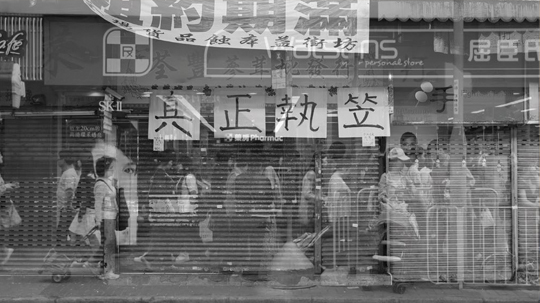DO ANDROIDS DREAM OF ELECTRIC SHEEP? THE PARADOX OF CHOICE IN THE TIME OF ANXIETY
| May 17, 2013 | Post In LEAP 20

There is something about Hong Kong’s urban landscape that invokes the dystopian future envisioned in Philip K. Dick’s 1968 Do Androids Dream of Electric Sheep?— a sci-fi tale of the android bounty hunter Rick Deckard and his chase for murderous, thinking robots set in a consumer-saturated city. Perhaps this is why curator Qinyi Lim chose to show a group exhibition of the same name with the subtitle “The Paradox of Choice in the Time of Anxiety,” so as to explore the ideology of choice and the illusion of freedom choice brings.
The show opens with a series of woodcuts by Sun Xun followed by the artist’s animation Some Actions Which Haven’t Been Defined Yet in the Revolution (2011), on view in a darkened room. It bears all the hallmarks of William Kentridge’s dark and fraught animated fables of man, here shown in a state of squalor with images that tremble and shake like the film’s characters, who include a barking bulldog and a man masturbating. It is an anxious work once described by Liu Xi as “composed by interweaving fragments of both latent and manifested meanings; it is both a revolution and a metaphor for our revolutionary desires” (see LEAP 14).
From this black space there is a tight corridor where walls display quotes, including Rick Deckard explaining how much he wants a real animal because keeping a fake one was almost worse than having no animal at all. There is also a graph charting Hong Kong’s “Index of Consumer Confidence” between 2007-2012, and quotes from Renata Saleci’s On Anxiety and Ed Bernays’ Propaganda. The nephew of Sigmund Freud, Bernays is featured in Adam Curtis’ The Century of the Self (2004), which traces the impact of Freud’s theories of psychoanalysis on modern society. This documentary is on show in the next room alongside Tang Kwok Hin’s installation Lower Legs (2012), which consists of street signs erected in the center of the space, a mosaic made out of beads on one circular sign surface, and a small digital screen on another emanating the sound of the TVB Evening News over visuals of static. Meanwhile, cardboard cut-outs of the same suited man photographed in various poses form Michael Lee’s Skive: A Worker’s Guide (2005/2007), are arranged on the gallery walls like stalactites from a cave, or parasitic growth spilling out of cracks and air vents.
The four-part The Century of the Self tells the story of how propaganda, which functioned as away to promote peace during wartime, was rebranded as “public relations” after World War II by Ed Bernays. Curtis explains how Bernays was the first person to take Freud’s ideas about human beings and use them to manipulate the masses, showing American corporations how to make people want things they do not need by appealing to their unconscious desires— “the start of the all-consuming self which has come to dominate our world today.”
On the adjoining wall, Tang Kwok Hin’s Present “Reminiscences of the Eastern Capital” (2012-ongoing) produces an eerie, textual layer to Curtis’s documentary. Three screens present sequences of black-and-white images of Hong Kong superimposed on others, fading and changing to create ghostly and transient city streetscapes where people dissolve into various scenes— shop windows, queues at bus stops, passing cars. Here, the question of Hong Kong and everything it stands for— its consumer indexes, its politics and its anxieties, the pace— is turned back on the very thing on which society is built, and for whom society essentially serves: the individual. What the individual desires, and how such desires might produce a city like this one (or the city Rick Deckard lived in, for that matter), becomes the case and the point.


